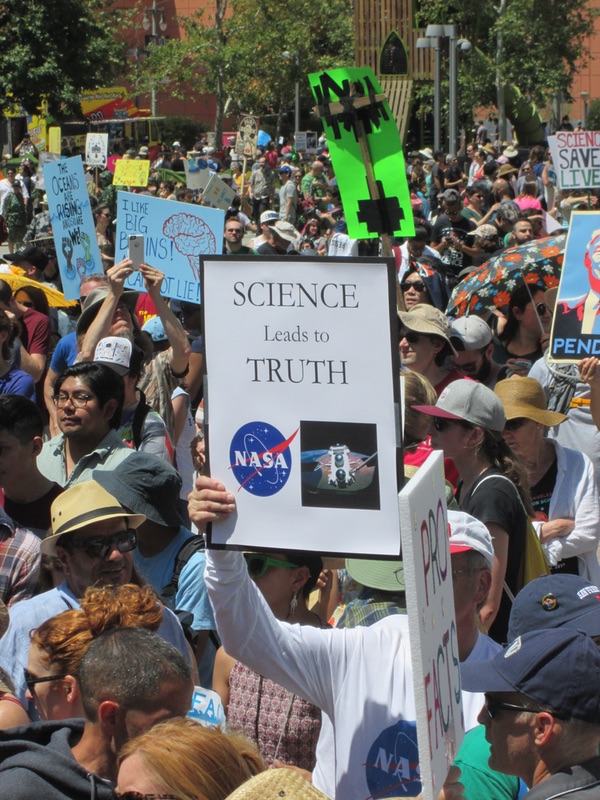
Earth Day 2017: Space and science on the march in Los Angelesby David Clow
|
| The current debates over NASA priorities under the Trump Administration was implicit in the signs and the speaker messages. While the event was a general affirmation of applied empiricism, climate change was the specific issue that seemed most urgent for the marchers. |
The local messages in Los Angeles reflected Southern California’s strengths as a global resource in education, government, and the private sector. “We’re not lobbying for any specific policies,” Alex Bradley, a UCLA PhD candidate in molecular biology, told the Los Angeles Times. “We’re just asking that policymakers consider the available evidence before making decisions.”
NASA’s contribution to the question, and the current debates over NASA priorities under the Trump Administration, was implicit in the signs and the speaker messages. While the event was a general affirmation of applied empiricism, climate change was the specific issue that seemed most urgent for the marchers. They had a message for the White House: the proposed shift in NASA’s direction indicates a policy of deliberate disinterest from this administration in the space-based evidence gathering that underlies many of the terrestrial issues of climate change and its already-visible effects on business, medicine, agriculture, and more. The demonstrators’ message: disinterest is not an option.
Compared with deeper cuts proposed for other federal agencies in the administration’s fiscal year 2018 budget request, NASA looks relatively unscathed with $19.1 billion. The Administration’s budget took issue with some deep space work such as the Europa lander and the Asteroid Redirect Mission, but so far the Europa Clipper has survived as did the 2020 Mars rover. However, over $100 million was taken from four Earth science missions: the Deep Space Climate Observatory, the ocean monitoring program PACE, the Orbiting Carbon Observatory-3, and the CLARREO Pathfinder, for measuring atmospheric heat. It’s those missions whose payoff involves the issues that brought people out for the March for Science: better measurement and understanding of the effects of climate change.
 One of the NASA=themed signs from the march. (credit: David Clow) |
Perhaps even more fundamental to the purpose of the March for Science in Los Angeles and across the country is White House’s proposed elimination of the $115-million NASA Office of Education, whose scholarships, internships, and outreach programs from K-12 to postgrad help to produce not only the passion that brought millions of Americans into the streets on Earth Day, but also inspire the interest and train the workforce the nation needs for a 21st century economy. Given the urgency and the opportunity in transforming the national energy infrastructure for a changing climate, the argument that the private sector can and should pick up the slack is peripheral. The real question in the context of today’s inseparable economic and climate questions is one of speed, not principle. NASA’s greatest spinoffs are capable people who can help institutions, companies, and governments address the challenges before them.
The president’s Earth Day proclamation broke precedent by making no mention of climate change, while insisting that “Rigorous science is critical to my Administration’s efforts to achieve the twin goals of economic growth and environmental protection.”
“My administration is committed to advancing scientific research that leads to a better understanding of our environment and of environmental risks,” Trump said. “As we do so, we should remember that rigorous science depends not on ideology, but on a spirit of honest inquiry and robust debate.” Judging from the signs and speeches in Los Angeles and around the country, hundreds of thousands of Americans agree with the letter of his message, and disagree with how he intends to pursue it.